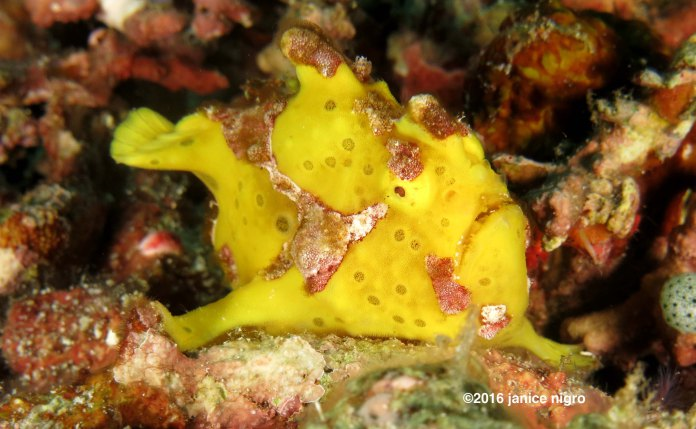I was calm, meditative…and then a bright yellow spot in the middle of the coral rubble grayness caught my eye. But it was moving! And it was moving with those tentative robotic steps of a frogfish. I was not that close, but I was sure it was a frogfish. I “called out” to my dive buddies through my regulator, “Hey!”, forgetting I could have banged on my tank with my stick, but they did not hear me. I settled down close to the rubble at 10 meters and began to watch my friend. He was already moving so it was not me who had disturbed him. He was slowly tiptoeing through the rubble as if he were trying to be invisible. He should have been, he probably thought. “I am a sponge.”
There is something special about making such a find on your own. You look across the expansive reef on dives like it’s infinity, wondering if you are still on Earth or in a dream. And then unexpectedly your eye catches something that’s different from the rest. It moves and you discover it. Dive guides do this every dive – “by accident” they say. “I know where to look.” “It’s my job.”
I did my best to photograph him, but he was moving. Even for a frogfish he was moving quickly. He was moving quickly yet deftly across the rocks like a climber looking for sure footing on a mountaintop. And he did not give me a big yawn. It’s a classic pose in frogfish photos, but a yawn is often a sign of stress.
My air was getting low, and the frogfish was disappearing into the rubble. It was time to leave. I threw him and the reef a kiss and started up the slope to do my safety stop with the others who had looked back occasionally to see if I was with them still. I had made them wait too many times before while I photographed crazy coral patterns or just another anemone.
I was going to wait until topside to show my guide Michael, but I could not contain my excitement. His eyes got big and there were a few frantic moments to go back, but it was too late…the frogfish was for my eyes only.
Tip: A dive is never over until it’s over.













































